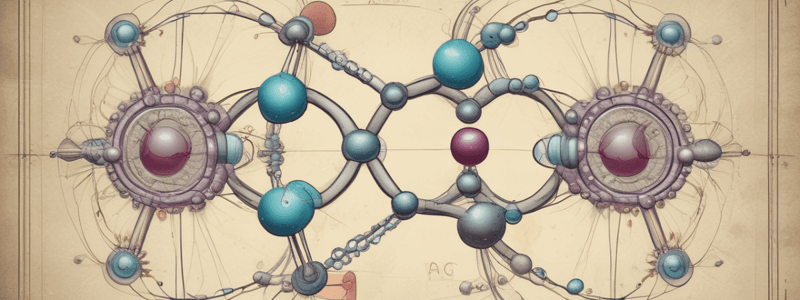Podcast
Questions and Answers
What is the result of the transfer of electrons in ionic bonds?
What is the result of the transfer of electrons in ionic bonds?
- Increase in the electrostatic repulsion between ions
- Formation of stable octet configurations for both metal and nonmetal atoms (correct)
- Formation of unstable electron configurations
- Breaking of the octet rule
Why do ionic compounds have high melting points?
Why do ionic compounds have high melting points?
- Due to the strong electrostatic forces holding the ions together in a lattice structure (correct)
- Due to the non-polar nature of the water molecules
- Due to the presence of free ions that can carry an electric charge
- Due to the weak electrostatic forces holding the ions together
Why are ionic compounds often soluble in water?
Why are ionic compounds often soluble in water?
- Due to the polar nature of water molecules, which can interact with the charged ions (correct)
- Due to the non-polar nature of water molecules
- Due to the weak electrostatic forces holding the ions together
- Due to the weak electrostatic repulsion between ions
What is the characteristic arrangement of ions in ionic compounds?
What is the characteristic arrangement of ions in ionic compounds?
What happens when ionic compounds are dissolved in water?
What happens when ionic compounds are dissolved in water?
What influences the properties of ionic compounds?
What influences the properties of ionic compounds?
Flashcards are hidden until you start studying
Study Notes
Formation of Ionic Bonds
- Ionic bonds are formed when a metal atom loses electrons to a nonmetal atom, resulting in the formation of positive and negative ions.
- The transfer of electrons leads to the formation of stable octet configurations for both the metal and nonmetal atoms, fulfilling the octet rule.
Characteristics of Ionic Compounds
- Ionic compounds, also known as salts, have a specific crystalline structure due to the arrangement of positive and negative ions in a repeating pattern.
- High melting points of ionic compounds are attributed to the strong electrostatic forces holding the ions together in a lattice structure.
Solubility and Conductivity
- When dissolved in water, ionic compounds dissociate into their constituent ions, allowing them to conduct electricity due to the presence of free ions that can carry an electric charge.
- Ionic compounds are often soluble in water due to the polar nature of water molecules, which can interact with the charged ions in the compound and facilitate their dissolution.
Properties of Ionic Compounds
- The properties of ionic compounds, such as their solubility, melting point, and conductivity, are influenced by the strength of the ionic bonds and the arrangement of ions in the crystal lattice structure.
Studying That Suits You
Use AI to generate personalized quizzes and flashcards to suit your learning preferences.




